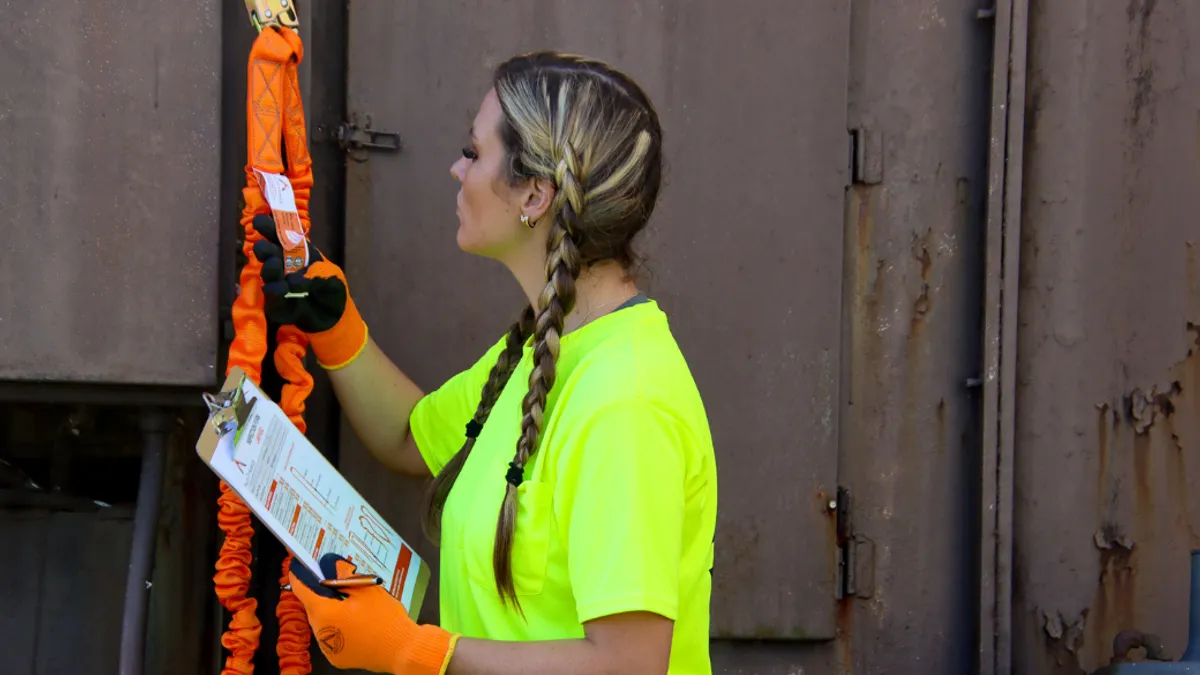Fall protection equipment is vital for protecting individuals working at heights. To ensure the equipment works efficiently and is in excellent condition, you must have your fall protection equipment inspected annually.
OSHA has many guidelines regarding fall protection systems so that workers can stay safe. One requirement is for employers to perform regular fall protection equipment inspections on harnesses, lifelines, lanyards, and self-retracting devices. Inspections help ensure that the equipment has been properly cared for and that workers are safe when using it.
Keeping workers safe is the top priority of any job site. That’s why it’s crucial to use the proper fall protection gear and equipment when working jobs at heights. Fall protection inspections are an important way to ensure your devices continue operating in their best condition.
Fall protection inspection requirements
According to OSHA guidelines, fall protection equipment must undergo an annual inspection. Depending on your equipment and working conditions, you may need inspections more often. OSHA specifies that the annual inspection must be done by a competent person — an individual who has completed competent person training and is appointed by your employer.
This annual competent person inspection may take a fair amount of time because it examines the specifics of each piece of equipment. The inspector will look at the equipment to ensure there are little to no defects, including:
- Significant tears, cuts, or undue stretching.
- Mold, mildew, or pests.
- Alterations that affect a worker’s efficiency.
- Deterioration damage.
- Corrosion.
- Faulty hooks and springs.
- Damaged or loose mountings.
- Non-functioning parts.
- Pre-Use Inspection
In addition to annual fall protection inspections, pre-use examinations should be performed daily. Pre-use checks are standard examinations you should do before putting on your fall protection gear – every time.
Check over all the pieces in your fall protection system to ensure they work and connect to each other properly and that all the writing on the manufacturer label is legible.
With daily pre-use inspections, you can catch instances of rust or deterioration more quickly and avoid work site incidents or dangers. These signs can indicate you may need a replacement sooner rather than later.
If you’re putting on a fall protection harness, ensure it’s a snug fit, and all the supporting grommets and D-Rings are in the right place.
Fall protection inspection documentation
Additionally, document all information from any annual or big fall protection equipment inspections — such as whenever you check your lifeline devices, harnesses, and lanyards. Documentation will help you keep track of your gear’s wear and tear.
Fall protection equipment reviews
Regarding equipment reviews, following the OSHA fall protection inspection requirements is crucial for your workers’ safety and continued productivity. Remember to have all your fall protection equipment inspected, even if it isn’t currently being used.
Regular inspections and periodic reviews
OSHA mandates regular inspections of fall protection equipment to identify defective components and ensure compliance with manufacturers’ fall protection requirements and recommendations. These inspections should be documented meticulously to maintain a log of equipment condition over time, helping to ensure that all equipment meets the necessary safety standards before use.
Periodic inspection frequencies may vary based on the conditions of use and exposure of the equipment to environmental factors. For instance, in highly corrosive environments or where the equipment is used daily, more frequent inspections are advisable.
Rescue preparedness and equipment
It’s vital for work sites to have rescue plans in place and rescue equipment readily available and inspected on a regular basis. This includes ensuring that all personnel involved in high-risk activities are trained on emergency procedures and the use of rescue equipment. Training should be provided by a competent rescuer who can educate workers on the correct usage of self-retracting lifelines, horizontal lifelines, and other critical safety equipment.
Each piece of equipment, from harnesses to lifelines, must be chosen based on the specific needs of the job and the environment, following manufacturer’s instructions to guarantee both effectiveness and compliance with safety regulations.
Ongoing commitment to safety in the construction industry
Maintaining a focus on occupational safety and adhering to OSHA’s regulations is an ongoing process that requires regular updates and continuous education. Ensuring that all fall protection systems and their components, including anchor points, are inspected on a regular basis is crucial for the safety and productivity of workers. These efforts help mitigate the risks associated with working at heights and ensure that all safety measures are effective and up-to-date.
Fall safety inspections with Malta Dynamics
If you need safety inspections completed, Malta Dynamics has you covered. We offer fall safety inspections as part of basic on-site hazard analysis to ensure you and your crew have the proper equipment and protection systems in place.
During this one-day inspection service, our trained professionals will go over the ABCs of fall protection training with your team. We’ll also complete a site walk, a safety equipment evaluation, and a basic assessment of your facility.
You can learn more about our safety inspection services or schedule a review with us by filling out our form or calling us at 800-494-1840.






